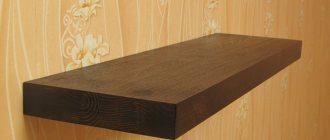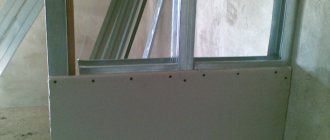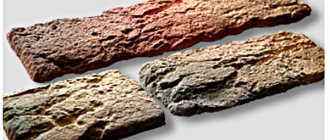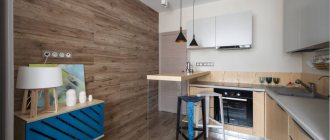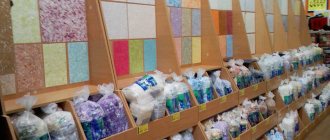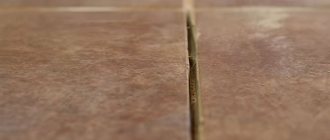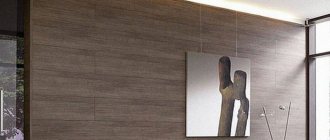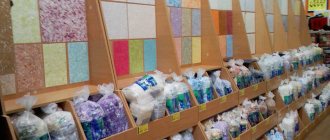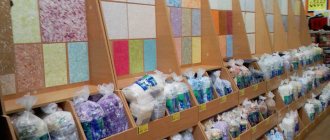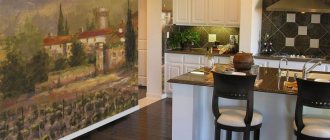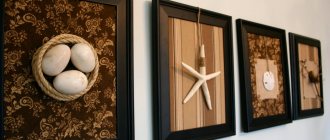“Flying” shelves are just shelves with hidden fastenings
The hidden shelf is a decorative accent that creates the illusion. The shelf seems to “float” on the wall. By adding such furniture to the interior of your living room, bathroom, kitchen, bedroom, you can solve the problems of storing books, necessary accessories or souvenirs. Such furniture is often required to decorate children's rooms, which have a lot of tiny cars, dolls or other toys. “Floating” shelves are cheap, beautiful, keep everything safe on them, and it takes little time to make such furniture.
Fastening glass shelves
Although the method of fastening glass shelves is a type of fastening using brackets, we will consider it as a separate issue. After all, the material used to make such products allows one to achieve interesting decorative effects.
Glass products can be:
Brackets for glass shelves are offered in design and size:
Since glass is a fragile material, this is taken into account in the design of the mounting brackets - they use silicone or rubber gaskets that protect the surface of the shelves both above and below
Rustic Bathroom Shelves
If it's time to modernize your interior, shelves with hidden fastenings in the Provence style are the perfect decor. She creates exclusively her own, unique home comfort. And at the same time it seems to be floating in the air! Its artsy yet simple appearance will brighten up the bathroom and any nook that needs storage space.
This shelf model installs as a floating shelf and is reinforced for added strength, making it a great storage option for collectibles, photos, keepsakes and glassware. The design is inexpensive and requires very few materials.
Advice. You should avoid last-minute shopping trips; it is better to prepare materials in advance.
Recommendations for the selection of hardware and their installation
Work on attaching the hanger to the wall begins by measuring the distance between the mounting points. Next, mark the holes for the dowels on the wall using a level and tape measure.
After this, you can drill holes in the wall for the dowels. Walls made of gypsum slabs or foam concrete blocks can be drilled with a simple drill. To prepare holes in a concrete or brick wall, it is better to use a hammer drill or drill with an impact function.
Typically, 6x40 mm dowels are used to attach shelves. For shelves with increased load, 6x60 mm dowels are used. In this case, part of the screw will extend beyond the dowel, and another part of it should protrude from the wall for fastening. That is, the self-tapping screw must be chosen longer than the dowel by 5-10 mm plus the size by which the hardware protrudes from the wall.
A self-tapping screw made of soft plastic compresses metal threads better than hard material. This ensures more reliable installation of fasteners. A regular dowel with a two-piece shank often doesn't work well, as the self-tapping screw can extend out of the plastic. As a result, the screw and dowel are not securely held in the wall.
It is better to use dowels, the diameter of which increases along the entire thread of the self-tapping screw as it is tightened. The simplest solution for choosing good dowels is to purchase products from a well-known company.
When drilling a hole for a dowel, you need to ensure the exact diameter and even hole. Ideally, the dowel can be pressed halfway into the hole with your finger, and then hammered in with a hammer. In this case, the plastic should not be deformed. To achieve the best result, you must first make a hole 1 mm smaller in diameter than necessary. Next, we work with a drill corresponding to the diameter of the dowel, that is, 6 mm in our case.
Source
Shelves-tubes for toys
If you want to keep your playroom tidy, you can easily make round shelves from empty paint buckets.
And, voila, the furniture is ready! This DIY shelf is an economical idea for creating storage space for small items.
Sliding shelves - a solution to eternal problems
For wine connoisseurs: how to make the right shelves with your own hands
Source
Progress
The design of the shelf consists of two parts: a frame - the shelf holder and a sleeve, which is put on the frame.
First, we make a holder from pine bars 1 by 2 cm thick (thicker is possible). You will need 2 bars 70 cm long (this is the length of the shelf), 2 bars 20 cm each and 5 bars 18 cm each. We connect them all as in the diagram with self-tapping screws.
The sleeve is made from two rectangles of plywood 72.5 by 21 cm, between which there is a “U”-shaped base of bars (see diagram).
When all parts of the shelves are ready, you need to sand them with sandpaper or a sander and paint the sleeves.
Now, using a level, screw the shelf holders to the wall.
Source
Sequence of work
Before you attach the shelf to the wall, you need to know that the thicker the shelf, the thicker the support should be. A hole is drilled in the end part an average of 5 mm below the surface. All holes for shelves in the wall must match, otherwise attaching them will be quite problematic.
Attaching the shelf to the wall:
- A strip of the required length is considered a template. It is applied to the end of the shelf and a hole of the required diameter is made, after which it is applied to the wall.
- The next step will be drilling, which must be done with maximum precision.
To attach the shelf you will need:
- electric drill,
- threaded coupling,
- brackets,
- lath - template,
- carpentry glue,
- screws.
Installation of a corner shelf (video)
Attaching shelves to the wall without visible fasteners
It is absolutely impossible to imagine an apartment or a house, and even more so an office, without shelves. These are very multifunctional pieces of furniture that are used both for decorating space and arranging various souvenirs, and for convenient storage of various things.
This is done in order to maintain the integrity of a particular style or for a number of other reasons. However, attaching shelves to the wall without visible fasteners is not such a difficult task as it seems at first glance.
Attaching shelves to the wall without visible fasteners
How to Attach Shelf Mounts to the Wall: Step-by-Step Guide
The standard method of attaching wall shelves is using brackets. The procedure for installing them:
- Mark the mounting locations for the brackets on the underside of the shelf. Check with a ruler (level) that the markings are correct.
- Screw the horizontal parts of the brackets to the shelf with self-tapping screws. At first, do not insert the screws all the way - you need to check the correctness of their position. After making sure that the fasteners are installed level, screw in the screws until they stop.
- Attach the shelf with brackets to the wall.
- Drill the first hole with a drill. Select the drill to match the wall material, the diameter to match the size of the dowels or anchors.
- Insert the dowel.
- Place the shelf and screw in the first screw not all the way.
- Mark the remaining holes. Check the markings with a level.
- Move the shelf, secured with one screw, to the side. Drill holes according to the markings and insert dowels.
- Do not screw in the remaining screws completely.
- Check that the shelf is positioned correctly. If the fasteners are installed level, then tighten the screws completely.
Small shelves (not made of glass) may not be attached to the holders, but simply placed on their horizontal parts.
How to attach a holder without visible fastening
When installing hidden fasteners, the accuracy of marking is of particular importance. Features of various methods of hidden installation:
- On the rods. The mounting plate located at the end of the rod is screwed horizontally to the wall using self-tapping screws and dowels. The shelf is “put on” on the protruding parts of the rods fixed in the wall.
- On the plates. They are screwed with self-tapping screws to the back of the shelf. To do this, recesses are made with a milling cutter or the back wall is installed so that it is “recessed” relative to the sidewalls by a few millimeters. Then there will be no gap between the product and the wall after installation.
- On hidden hinges. For them, grooves are cut out at the end of the shelf using a router so that the loop is flush with the edge. The fasteners are screwed in with self-tapping screws and the finished product is hung on screws in dowels pre-installed in the wall.
Do-it-yourself glass shelf fastening: features
When hanging glass shelves, pelicans and mensolo holders of a similar design are installed in the usual way using self-tapping screws.
The mounting holes on these fasteners are located on parts covered with decorative overlays. Before installation, these pads are removed and the holders are not fully drilled into the wall. After making sure that the position is correct, tighten the screws and put on the covers.
Fasteners for hanging shelves on a plasterboard wall
The best option for reliable fastening of shelves to gypsum plasterboard walls is to install additional horizontal profiles or embedded wooden blocks at their level during the installation of the frame. In this case, the self-tapping screws will be screwed into metal or wood, which will create a durable structure. If the wall is already covered with plasterboard and there is no way to make changes, then the way out is to use special dowels: umbrella, butterfly, Molly, Driva, Legs, Knauf Hartmut.
Shelves in a modern interior
In any house, if a person lives in it, there are always a lot of different jars, bottles, maybe books, souvenirs, photo frames and much more. And in order to keep order in the house, it is recommended to put each thing in its designated place. And often a wall shelf acts as such a place. It usually serves two functions - it is a convenient stand for something decorative or useful, and it can also be the highlight of a certain design.
Wall shelves in the interior
Depending on the room in which the shelf is installed, it can perform a very different role. So, in the kitchen there may be a set of spices on it or some elements of utensils. In the bathroom , a shelf is a must-have for arranging various bottles and bottles. A shelf is also needed in the bedroom , where you can place on it various things you need before going to bed. Of course, these interior elements are also in the living room - books, flowers, and souvenirs can be placed on them. Often they are able to significantly save space, as well as overcome clutter in the room, because from now on everything will be in its place. That is why this piece of furniture is absolutely irreplaceable, despite the fact that there may be many wardrobes or chests of drawers in the house.
Wall in the form of shelves
On a note! The shelf is appropriate and functional in absolutely any interior, regardless of its style. The main thing is to choose the right and suitable option and place it in a place where the shelf will look organic and as part of the interior.
Moreover, it is important to choose not only a shelf that suits the style, but also one that you will like and look aesthetically pleasing when hung. When creating certain styles, it is important that the fastenings on it are invisible. In general, there are several variations of fixing shelves on the wall.
Attach the shelf to the wall using a shelf holder
To begin with, I will point out that the shelves can be attached without any fear to brick walls with a thickness of at least 250 mm and to concrete walls with a thickness of at least 100 mm. Moreover, if the shelf’s width does not exceed 1.5 m, it can be mounted on two hangers. Otherwise, the number of mounting points must be greater. In other words, the shelf should not sag under the influence of objects stored on it.
There is a special fastener that allows you to attach the shelf to the wall unnoticed, without the use of additional corners. It consists of a bracket that is fixed to the wall through two holes and a rod screwed into it, onto which the shelf is placed. The oval shape of the holes allows you to adjust the height of the bracket, and two set screws allow you to adjust the tilt of the rod.
When installing a shelf, the bracket is first attached to the wall using two dowels and self-tapping screws, and then a shelf in which a corresponding hole has been prepared is placed on the rod. The shelf can be easily removed and put back on the pins to make level and tilt adjustments.
Brackets can also be simpler, both single and double. When using them, you need to be especially precise and careful during installation, since adjustments in this case are impossible.
There is an even simpler, at first glance, solution - hidden shelf holders with dowels. When installing them, it is enough to provide one hole in the wall into which the shelf holder is driven.
At the same time, such fasteners must be installed absolutely precisely in height, width, and inclination. Probably, the task can be simplified if the holes in the shelf are drilled after installing the holders, taking into account the correction of errors during their installation.
I note that the use of holders in the form of a rod that is inserted into the shelf is limited by its design and dimensions. So, its thickness cannot be less than 25 mm with a pin diameter of 12 mm.
How can I mount a shelf on the wall?
Table. Methods of fastening shelves.
Bracket or holders
| Mounting option | Short description |
| This option assumes the presence of visible fastenings for shelves. They can be seen, and they are fixed both below and above the shelf. The brackets can also be hidden. Visible brackets can be simple or decorative. They come in both plastic and metal, ornate and simple, etc. One side is attached to the wall, the other to the shelf itself. However, it is important to understand that this option is not suitable for every interior style. | |
| This is the choice of those who save on mounting costs, but want to install the shelf as quickly and easily as possible. It is suitable for almost every interior. Moreover, this is a fairly reliable fastener, and depending on its size, you can vary the load on the shelves. | |
| Fastenings for glass options | These fasteners are used only for fixing shelves made of glass and characterized by their large mass and fragility. They are usually made of metal and have special gaskets that will allow you to securely fix the shelf itself to the wall, preventing it from falling. There are also suction cup fasteners for glass, but they are not very reliable. As a rule, the suction cup is fixed on the underside of the shelf. Typically, such fasteners are small in size. |
| This option will allow you to install the shelf so that the fasteners themselves will not be visible from any side of the shelf. It will seem like it's just glued to the wall. |
Concealed shelf holder
Types of fastenings
Shelf mounts are selected taking into account the weight, design features and material used to manufacture this interior element, as well as the type of surface on which they will be installed.
Types of fastening shelves to the wall differ in structure, design, method of fixation and support. The most popular type is visible fittings, usually brackets. They are the easiest to install, can withstand the heaviest loads, and provide reliable support.
Attaching shelves to the wall without visible fasteners is more difficult. In addition, this option is not suitable for all walls - a solid base is required: concrete, brick.
Some structures, for example, gypsum plasterboard partitions, must be thick enough to allow shelves to be hung on them in this way.
Mounts without visible fasteners
Many people now choose fastenings without visible fasteners, since this option involves completely invisible fixing of the shelf on the wall , without unnecessary elements. It is the reluctance to see additional elements on the walls for one reason or another that drives the owners of shelves and apartments to choose this option.
Brackets for mounting shelves in the wall
There are three options to secure the shelf to the wall so that the fasteners are not visible.
DIY zigzag shelf made of chipboard
Fastening with metal pins
Hidden fastening of shelves to the wall without visible fasteners
The most reliable option for fixing the shelf is with metal pins, as this will provide the ability to seriously load the shelf. Moreover, this is the most inconspicuous option, even in comparison with other methods related to secret ones.
Removing invisible fasteners
It happens that the hidden fastening and the interior element itself are no longer needed, they have to be dismantled. First, the structure itself is removed from the fittings, the metal elements are pulled out with pliers.
Use a screwdriver or screwdriver to unscrew all remaining parts, and seal the holes in the wall. Installing or removing a shelf with invisible fixation is not difficult - it does not require special knowledge or skills. All work can be done in literally half an hour.
How to choose a fixation type?
This is not an easy task, since when choosing a method for attaching shelves, several factors must be taken into account. And they are the ones who will influence the final decision.
Brackets for mounting shelves in the wall
Relationship between shelf depth and load on each mensolo holder
Important! You can choose the right mount only if you know the answers to the questions: “What will stand on the shelf?” and “Which wall will the product be fixed on?”, only then can you make the right choice.
It is also important to estimate the number of fasteners in advance. So, if the shelf is shorter than 1-1.5 m, then a couple of fasteners are enough. If the length is greater than the specified parameters, then it is better to increase the number of fasteners in order to evenly distribute the load on the product and the wall. Moreover, again, the number of fasteners can vary greatly depending on the thickness of the shelf itself and its quality.
The free space above the sofa is organically filled with shelves to match the walls
What influences the choice of fastening
There are different options for hidden fasteners, which differ in price, type, shape and other characteristics. In any case, when using this method of fixing structures, you need to consider the following points:
- Wall thickness. This indicator is especially important when it comes to pin fastening. It can be used only if the thickness of the concrete wall is 10 cm or more, the thickness of the brick wall is from 25 cm. For bases that do not meet these parameters, it is better to choose a different type of invisible fastening or use additional fittings. If you do not strengthen the fasteners, then only the lightest items can be stored on the shelf - a couple of jars of cosmetics, jewelry.
- Shelf thickness. For small loads, it is enough to install a product 3 cm thick; for heavier items, you will have to buy shelves 4.5-6 cm thick. It is important that the structure is strong, solid, with a flat surface.
The number of fittings also needs to be thought out in advance. For shelves shorter than 1 meter, only two fasteners are sufficient.
Important! If the length of the product is longer, you must add fasteners - this will allow you to evenly distribute the load.
Fixing the shelf on the wall using hidden fasteners
Step 1. In order to fix a shelf on the wall using a hidden fastening option, you will need to prepare a hammer drill with a drill of a certain section, 2-3 special titanium pins, a building level, a square, a drill and a bit, the shelf itself, and a pencil for marking. The pin is a metal rod that is threaded on one side and smooth on the other. The threaded part will screw into the wall, and the smooth part will need to be fitted with a shelf. Typically the pin diameter is 10-12 mm. The drill is selected with the same diameter as the purchased titanium.
Special metal pin
Step 2. First of all, you need to apply markings to the shelf itself. By the way, you can make it yourself from any part of other furniture that has served its age, rather than buying new one. Using a ruler, you need to set aside the required distance from the end edge of the shelf. In this case, a distance of 12 cm was chosen.
Step 3. Having chosen the distance, you need, using a square and a pencil, to draw a line perpendicular to the plane of the shelf at the end where the hole for fastening will be drilled.
A perpendicular line is drawn at the end
Step 4. Next you need to find the middle of the end of the board and make a corresponding mark for the drill. It is important to understand that if the shelf consists of two sheets of chipboard glued together, then in this case it is better to drill a hole for fastening not in the middle, but with a slight offset towards one or another board (better - towards the bottom, it will be more reliable).
A mark is placed for the drill
Step 5. Similar markings must be applied on the opposite side of the shelf.
On the other side the same markings are applied
Step 6. Next, to the end of the shelf where the markings are applied, you need to attach a building level and directly on it make marks parallel to those previously applied to the board, as well as marking the edges of the shelf itself. The level cannot be moved while the marking is being transferred. Pencil marks can then be easily erased from the surface of the level, but this technique of transferring markings will make it easy to make markings for drilling holes in the wall.
The level cannot be moved while the marking is being transferred.
Marks are made at the level
Step 7. Then you need to select the approximate location of the shelf on the wall. Having applied it to the surface, you need to mark the boundaries of the product directly on the wallpaper with a pencil.
The shelf is attached to the wall
The boundaries of the shelf are marked
Step 8. Now you need to take a building level with markings and, attaching it to the wall in the selected and marked place, align and transfer the markings from the level to the wall, also using a pencil. In this way, you can easily and quickly make precise markings for the locations for drilling holes for the pins without unnecessary movements.
Transferring markings from level to wall
Step 9. Next, in the end part of the shelf, in the designated places, you need to drill holes for the pins. They should be the same depth as the length of the part of the pin on which the board will be placed.
A hole is drilled in the end
The depth of the hole should correspond to the part of the pin on which the shelf will be placed
Step 10. Now you need to take a hammer drill with a drill of the same diameter as the pin and make holes in the wall in accordance with the previously made marks. To prevent dust from concrete from falling onto the floor, it can be removed immediately using a switched on vacuum cleaner, the hose from which will be held by an assistant.
Holes are made in the wall
Step 11. Both titanium pins need to be installed in place, that is, inserted into the holes in the wall. If they are difficult to enter, you can carefully knock them out with a hammer or screw them into the wall using a key.
The pins are inserted into the holes
Step 12. All that remains is to put the shelf on the pins in the wall, aligning the holes with the metal fasteners. The shelf is installed. By the way, for better fixation, you can add a little glue to the holes of the shelf - then the connection will be even more reliable. This mounting option will allow you to achieve an effect where it seems as if the shelf is supported on the wall by itself.
The shelf fits onto the pins in the wall
Finished shelf without visible fasteners
Video - How to install a shelf with invisible fasteners
Installation of fasteners
Installation of fastening the shelf to the wall with your own hands is carried out according to the following algorithm:
- choice of fastenings;
- preparation of instruments;
- fixing the shelf to the wall.
Selection of fasteners
When choosing fasteners, consider the following parameters:
- the material from which the wall is made. You can hang shelves on brick and concrete walls in any way. For plasterboard walls, it is recommended to select stronger fasteners;
- the material from which the shelf is made. Massive fasteners are not suitable for glass shelves, as they make the structure too heavy. For metal shelves, external fasteners are best, and for wooden shelves, internal fasteners are best;
- thickness and other overall dimensions. For massive shelves, it is recommended to select similar types of fastenings: large brackets, hidden metal rods, and so on. For light, thin shelves intended for storing souvenirs, cosmetics, and so on, it is advisable to use small corners.
Related article: Insulation of external walls of a house with polystyrene foam
Additionally, it is worth considering the number of fasteners. If brackets, corners or hinges are used, their number cannot be less than 2 pieces, located on each side of the shelf. If the shelf length is more than 1 - 1.5 m, it is recommended to increase the number of fasteners.
Preparing tools
To complete the installation work, you will need to prepare the following list of tools:
- ruler, tape measure and marker for marking;
- building level for leveling in a horizontal position;
- drill. If installation is being carried out on a brick or concrete wall, then it is recommended to use a hammer drill instead of a drill;
- screwdriver or screwdriver, hammer;
- dowels, screws and other fasteners.
Shelf fastening
The instructions for attaching the shelf are as follows:
- At the first stage, it is necessary to determine the place where the shelf will be hung and mark the location of the fastening elements. When applying markings, it is important to take into account the horizontal level of the piece of furniture, since otherwise it will be impossible to put anything on the shelf;
Determining the locations of fasteners
- hole preparation. Before attaching the elements fixing the shelf, it is recommended to pre-drill the holes, even when attaching to a wooden wall;
Preparing holes for mounting the shelf
- installation of dowels. If the shelf is hung on a brick or concrete wall, then before fixing it with self-tapping screws, it is necessary to install plastic dowels, which allow for a stronger adhesion of the fastening element to the wall. Dowels can simply be hammered into the holes;
Installation of devices for reliable fixation of the shelf
- fixing the selected mount to the wall using self-tapping screws of a suitable length;
Fixing the selected fastener to the wall
- fastening the shelf to the bracket. If fixation is carried out using hidden metal rods, then before fastening it is necessary to drill holes in the shelf of appropriate size and length;
Fixing the shelf on the fastening element
- checking the correctness of the work. At this stage, it is necessary to check the reliability of the shelf fastening, applying the maximum permissible force to the piece of furniture (for example, you can lean your elbows or hang slightly on the shelf) and the horizontal installation using a building level.
Checking that the shelf is installed correctly
How to install a shelf with hidden fastenings, watch the video.
To secure the shelf, you can use other completely different objects, for example, thick leather belts. Unusual types of fastenings will add individuality to the interior of the room.
Fixation on drywall
Many people now prefer to line the walls with sheets of plasterboard or make room partitions from this material. And it is clear that attaching shelves to it using pins is not the best option. Drywall is a fairly thin and fragile material, not designed for heavy loads . So the option of hanging shelves on the partition is completely eliminated.
Types of fasteners for drywall
But if the walls were leveled with plasterboard and it was already known where the shelf would hang, then you can use a trick and still use invisible fasteners. To do this, it is enough to install a reliable wooden block between the wall and the sheet of drywall in the place where the shelf will be attached. Next, you will need to fix the shelf itself so that the pins pass immediately through the drywall, through the block, and through the concrete wall. However, it is important to understand that such a piece of furniture should not be heavy in itself, and you should not place massive or significant objects on it. Also, special fasteners for drywall can be used to fix lightweight shelves.
That, in fact, is all that could be said about invisible options for attaching shelves to walls. Everything is quite simple and should not cause any difficulties even for a beginner in this matter. The main thing is to purchase everything you need in advance, and the work can be completed within 30-40 minutes. A shelf will appear on the wall that will stand “by itself.”
Source
Types of fastenings
To attach the shelf to the wall, you can use:
- exposed (visible) fasteners;
- hidden fasteners that are invisible to the average person.
Exposed Fasteners
Open fasteners include:
- brackets of various configurations and sizes. It is recommended to use such a shelf fixing element only if it fully matches the design of the room;
Shelf holders of different types
- metal corners. The devices are the simplest, most common and reliable fastening elements. Can be installed in rooms with any finish;
Corners for fixing shelves
- loops. They are also a common option. Easy to install and reliable;
Open loops for hanging shelves
- holders. Used advantageously as fastenings for glass shelves. Can be of different shapes, colors and different sizes.
Holders for shelves made of glass
Hidden fasteners
Fixation with hidden fastening is carried out using:
- hidden loops. A special structure is installed inside the shelf, which rests on a bolt screwed into the wall. From the front side, neither the hinge's retaining hole nor the bolt are visible;
Fixing the shelf with hidden hinges
- metal rods that are attached to the wall and “recessed” inside the shelf.
Using metal rods to secure the shelf
Attaching shelves to the wall without visible fasteners
With all the variety of existing methods of interior design and modern design, it is almost impossible to imagine a modern room in which shelves would not be used.
Decorative and easy to store various small items, massive for books - shelves can not only be an additional useful surface, but they can also act as a decorative decoration for any room or office.
There are two main ways to attach shelves:
The traditional method of fastening using various types of brackets, metal or wooden racks is popular only when the fasteners, correctly selected in color, texture and material, also add their own “zest” to the artistic image of the room.
But often, the presence of additional decorative and technological elements is not always consistent with the overall design of the designer and the target orientation of the structures. In this case, it would be better to use the second fastening method.
The development of modern design craft and the construction industry makes it possible not only to quickly cope with the task of hanging shelves, but also to successfully use the fastening of shelves to the wall without visible fasteners, thereby creating the illusion of floating in space.
Invisible fastening of shelves to the wall
Let's consider the main stages of properly attaching a shelf to the wall, while hiding all fastening elements:
With a brick partition thickness of 250 mm or more, concrete partitions with a thickness of 100 mm or more can be safely used for hanging shelves without additional load-bearing structures.
Scheme of invisible shelf fastening.
1 – bracket for fastening the shelf; 2 – mounting holes; 3 – steel axle; 4 – suspension; 5 – shelf.
With thinner bricks, cinder block and plasterboard walls up to 100 mm, it is possible to use invisible fastening of shelves to the wall, but such shelves are suitable only for decorative purposes.
Since they simply will not withstand additional loads.
Then you need to determine the thickness of the shelf itself.
It can be determined by placing a load of expected weight on it. The absence of visual deflection and deflection to the touch indicates sufficient thickness of the board.
An exception may be cases when the choice of a thicker board is dictated by the general concept of the interior.
However, it is also necessary to take into account the fastening features, due to which the thickness of the board, as a rule, cannot be less than 30 mm. The thickness of the shelf must be selected depending on the load, for example, for books - boards with a thickness of 45 to 60 mm are suitable.
The board must be dry and processed in accordance with its purpose.
Types of fastening shelves to the wall
After this, the types of fastening the shelves to the wall are selected, depending on its purpose and the thickness of the board.
There are a huge number of fastening materials that can be expertly hidden from prying eyes; let’s look at some of them:
Fastening technology using hinges:
For accurate hanging, you need to accurately measure the distance between the centers of the loops. This distance will determine the markings on the wall for the mounting holes. To ensure that the shelf hangs evenly and does not warp, it is better to use a building level, which will ensure an accurate horizontal line for the shelf. After the holes in the wall are drilled in accordance with the markings, they are filled with a plug into which screws are screwed. The screw should be screwed in deep enough, but the distance between its head and the wall should allow the shelf hinges to be put on.
The shelves come complete with special fasteners designed for invisible installation. A shelf installed in this way will be securely fastened. This will create a visual impression that it is literally hanging in the air.
Method of installing shelves using special furniture fittings
Let's look at the step-by-step implementation of this installation.
It starts with purchasing a modern shelf in a furniture supermarket or online store.
Step 1. Measure the distance between the centers of the mounting holes directly on the product.
Step 2. After this, mark the location of the shelf on the wall. Using a building level, we draw a horizontal axis on which we mark the position of the mounting holes, taking into account the center-to-center distance between them.
Step 3. Next, we attach the bracket to the resulting axis in the center of the shelf holes and mark the places for its future attachment to the wall. They must be located strictly along the horizontal axis.
Step 4. The next step is to drill a hole for attaching the brackets. They must be made strictly perpendicular to the wall, this will ensure that the shelf angle is 90 degrees relative to the wall. To simplify drilling, it is advisable to use a square.
Step 5. Next, remove the remaining drilling products from the holes and hammer in wood plugs or plastic dowels.
Step 7. Now we carry out the direct installation of the shelf. To do this, we put it on the steel axles of the brackets, alternately tapping it with a rubber hammer on the left and right sides in the front part. The shelf will be evenly installed on the fastening elements, eliminating distortions.
Step 8. The final stage will be to check the play and reliability of the fastening. After this, we remove the remaining debris and install a flowerpot with an orchid. The installation process is complete.
What kind of fasteners for shelves on the wall are there: types by type of fastening
Mounts for wall shelves are divided into two types: for open and hidden (secret) installation. The second option is more difficult to implement; it is used when it is important that the fasteners do not take up space on the wall or are simply invisible; it is only suitable for products made of wood, chipboard, and MDF. All types of fastenings are fixed to the walls with self-tapping screws and dowels, and in difficult cases (plasterboard, thick layer of plaster, etc.) with anchors.
There is an opinion that it is better to use wooden plugs (chops) instead of dowels, but professionals say that wood, sooner or later, dries out.
Hidden fittings without visible fastening
Visually, hidden installation adds lightness to the structure and expands the space. There is no need to match holders by style, color to shelves or furniture.
Types of fastening for hidden mounting of wall shelves:
- Rods. Under them, holes are drilled in the shelf itself with a depth of 2-5 cm shorter than the width of the product. Fastenings of this type can be made independently from steel reinforcement or using threaded rods with anchors. The diameter of the rod (at least 10 mm) is selected taking into account the expected load and the weight of the product itself. There may be a plate at the end of the rod; there are options with two or more rods on one common bar.
- Plates. They are hung on screws and dowels screwed into the wall. This option is used for attaching two- or multi-level shelves and open wall cabinets.
- Wooden bars. They make up a frame and attach it horizontally to the wall. A shelf consisting of two boards and side walls between them is put on the fixed grille as a cover.
- Hidden hinges.
Open shelves, fixed in a secret way, seem to grow into the wall, without any support. That's why they are called "floating".
Exposed Fasteners and Brackets
The standard way to hang shelves is to use regular visible fasteners. They are mounted on the wall under a shelf. Disadvantages - they take up space, sometimes it is difficult to choose a good combination with the material and color of the attached product.
Types of open holders for wall shelves:
- Corners (simple brackets). Maximum load is 20 - 40 kg, the exact value depends on the design and fastening material.
- Reinforced brackets. They differ from the usual ones by the presence of a jumper between the vertical and horizontal parts of the corner. Permissible load up to 100 kg.
- Decorative (mensolo holders). This is a type of corner, the maximum load is from 10 to 30 kg. A distinctive feature is its attractive external design; such a holder can become an independent interior detail. They are selected to match the style of decoration and furniture in the room - antique, modern, techno, etc.
- Reiki. They can be made of wood or metal, installed horizontally (under one shelf) or vertically (under several levels).
Corners and reinforced brackets are usually used in utility or auxiliary rooms; decorative mensolo holders are more suitable for living rooms and offices.
